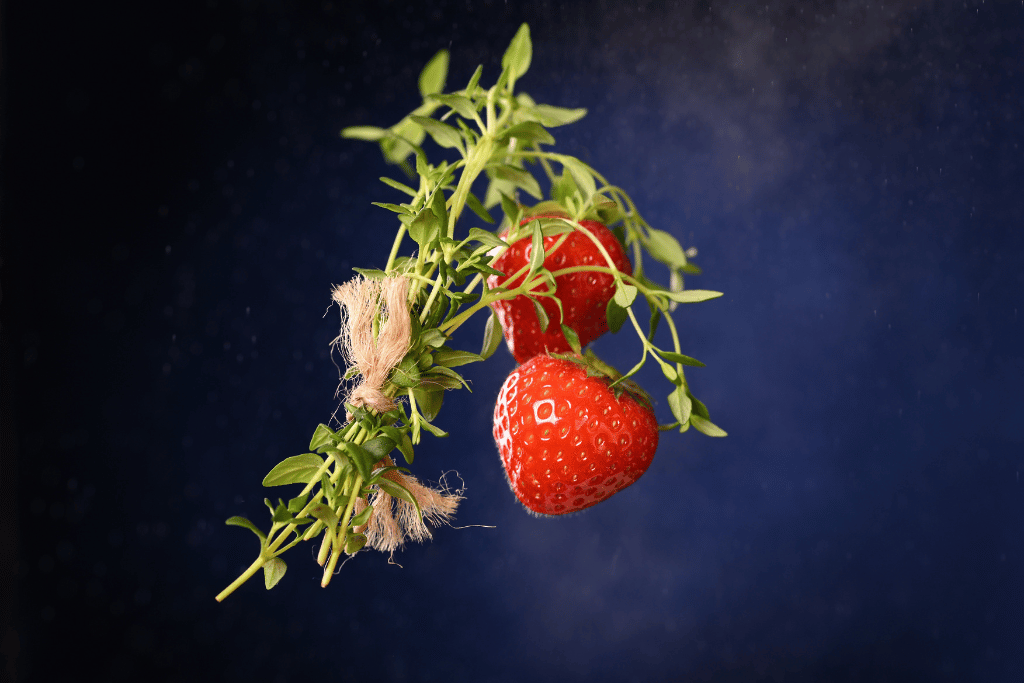
The smell of thyme always takes me right back to my childhood.
I was a little bit of a fussy eater when I was young (I’ve sinced changed my ways to be a more adventurous eater.)
But there was always one dish my Mother made that I would gobble down until my belly was about to burst.
As far as I’m concerned, it’s her signature dish: Lemon thyme chicken.
Chicken breasts cooked in a buttery, citrusy herb gravy, served over mashed potatoes with a side of broccoli. Delicious!
It’s still a meal that I request to this day.
And the ingredient most important (aside from motherly love) that makes it a superlative supper?
Thyme. The simple, humble herb makes a great dish outstanding.
And it will do the same for your garden, if you let it. Thyme will perfectly complement some of your favorite vegetables, fruits and herbs by bringing into harmony all of their best qualities..
Now Is the Thyme to Companion Plant
Thyme is a hardy, versatile herb that has many advantages in the garden.
- First of all, Its intoxicating aroma wards off many garden pests and can help improve the flavor of other garden crops.
- Thyme is a low-maintenance, hardy perennial that is drought tolerant; talk about easy to care for!
- And it can be squeezed into just about any open spot in the garden, as it requires very little space to establish.
Try planting it along walkways or in open spaces of garden paths. Thyme holds up to foot traffic and will give off its trademark fragrance everytime you come into contact with it.
Let’s take a closer look at all of thyme’s closest garden companions.
Tomatoes
Thyme’s strong essence will drive away a primary antagonist of tomatoes, the tomato hornworm. These giant green caterpillars devour the stems, foliage and fruit of tomato plants at an incredible rate. Anything that keeps them away is worth keeping nearby your tomato plants.
The taste of tomatoes is said to be enhanced by the presence of thyme. Homegrown tomatoes typically have a rich flavor; why not kick it up a notch? Dried thyme leaves also make a pleasant seasoning to add to your homemade tomato sauce.

Rose Bushes
If you’re a flower enthusiast, thyme should be your new best friend. Plant it around your roses to keep them free of typical pests like aphids and blackflies

Potatoes
Potatoes seasoned with thyme is a simple, earthy delicacy. So is it any wonder they complement each other just as well in the garden?
Thyme attracts parasitic wasps that will prey on potato beetles, deterring a major problem for the spuds.

Eggplant
Just consider thyme an all natural, organic pest repellent. Planted close to eggplant, it will drive away moths and other common pests.

Brassica Vegetables
Plant thyme alongside vegetables like cabbage, broccoli, Brussels sprouts, kale and cauliflower to keep away a whole slew of pests.
Brassicas are easy to grow but difficult to protect from pesky insects like cabbage worms, cabbage moths, cabbage loopers and flea beetles.
Companion planting with thyme will make sure these destructive pests don’t decimate your brassica crops.

Lavender
Is there anything lovelier than the scent of lavender?
Well, maybe the fragrance of thyme!
Good news herb lovers; you will not have to choose between the two.
Thyme and lavender both thrive in the same conditions and can therefore be planted closely together.
Lavender and thyme? That sounds like the perfect foundation for an herb garden to me.

Rosemary
Another Mediterranean herb in contention for first place fragrance is rosemary. Due to their shared origins, thyme and rosemary require the same growing conditions, making it a no-brainer to plant them in the same space.

Blueberries
Thyme will help repel pests that tend to bother blueberries. Like all sweet fruits, blueberries need all the help they can get when it comes to pest defense. So planting thyme close by is a good idea. Thyme’s tiny blossoms attract all sorts of beneficial bugs helping pollinate blueberry flowers and leading to a large, healthy yield.
Blueberry thyme also sounds like the hot new kombucha flavor, doesn’t it? I know I’d give it a shot.

Strawberries
The bright red berries are a favorite of many. Unfortunately this includes bugs, slugs and rodents. Weaponize thyme’s strong scent to deter these nasty pests and keep your strawberries protected. There’s no place for any critter among your strawberry patch.
Consider planting thyme in between rows or sporadically among your strawberry bed to help suppress weeds and shade the soil.
It’s been said that thyme can increase the growth rate and yield of neighboring strawberry plants. It’s worth a try!

What NOT to Grow Near Thyme
As agreeable as thyme is, the perennial herb sadly doesn’t get along well with every plant. Luckily, the list is short. Don’t plant thyme near these crops:
Chives
Thyme and chives have conflicting growing conditions. Chives prefer nutrient rich and well-drained soil. Thyme prefers things on the drier, sandier side and therefore will not thrive growing alongside chives.
Basil
Thyme and basil require different growing conditions. Basil mostly prefers the companionship of vegetables rather than other herbs. Keep the two separate and select better growing buddies for your thyme and basil.
Cilantro
One more herb that won’t get along well with thyme is cilantro. Cilantro prefers cool, moist soil whereas thyme would rather have warmth and sandy soil.
Thyme Tested Friend
Thyme is an exceptional herb that fills various roles in the garden. Many crops greatly benefit from the company of thyme and its versatility in the kitchen is beyond compare.

I believe thyme earns a place in every garden space as a perennial, pest deterring, drought tolerant, flavor enhancing aromatic herb.
Is there anything it can’t do?
Oh, and be sure to dash some lemon and thyme into the next chicken dish you’re cooking, you won’t regret it!



